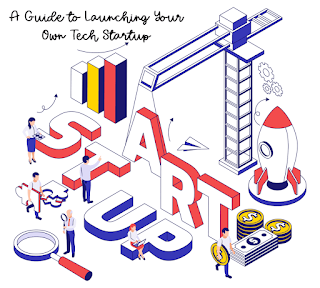From Idea to Execution: A Guide to Launching Your Own Tech Startup
Introduction
Launching a tech startup is a challenging but rewarding endeavor. With the right idea, team, and execution, you can build a successful company that solves a real problem and makes a positive impact on the world.
Starting a business is exciting and satisfying but there are hurdles along the way. The process entails a number of processes from developing a business concept to offering your item or service and starting a prosperous company.
 |
| A Guide to Launching Your Own Tech Startup |
This guide will take you through the sequential stages of launching your startup. It encompasses everything from validating your idea to securing funding and finally launching your product or service.
Steps for Launching Your Own Tech Startup
Step 1: Generate and Validate Your Idea
Validating your company idea is the first step. To do this, you must make sure that your product or service both answers a real need or problem and that there is a market for it. Market analysis, conversations with potential clients, and surveys may all help with validation. It's also crucial to develop a prototype or minimal viable product (MVP) to test with real consumers.
Before you invest too much time and money into your startup, it's important to validate your idea and make sure there is a market for it. Talk to potential customers, conduct market research, and build a prototype to get feedback.
Step 2: Conduct Market Research
Understanding your target market, their demands and the competitive environment need conducting market research. This knowledge makes it easier to create a good or service that appeals to customers and stands out in the market. Your target market should be identified, your rivals should be analyzed and current market trends should be recognized.
Step 3: Create a Business Plan
A business plan serves as a road map for your firm by detailing objectives, plans, and budget estimates. It works as a tool to entice partners and investors. An executive summary, company description, marketing plan, operations plan, and financial predictions are all included in a complete business plan.
Include the following elements:
- Executive Summary
- Market Analysis
- Competitive Analysis
- Business Model
- Marketing and Sales Strategy
- Financial Projections
 |
| A Guide to Launching Your Own Tech Startup |
Before you proceed, make sure you address the legal and administrative aspects of your startup:
- Choose a Business Structure: Decide whether you'll form a sole proprietorship, partnership, LLC, or corporation.
- Register Your Business: File the necessary paperwork and obtain any required licenses or permits.
- Intellectual Property: Protect your intellectual property through patents, trademarks, and copyrights.
Step 4: Team Building
Assemble a team with the skills and expertise required to execute your startup's vision. Look for individuals who share your passion and dedication. It's not necessary to find team members that look like you or have your same skills, you rather need to look for members who complete you not compete with you.
Step 5: Build a Prototype or MVP
Creating a working model of your product or service, known as a prototype or MVP, is crucial for early testing and feedback. The prototype doesn't need to be perfect initially; it's preferable to start with a simple version that can be refined based on user feedback.
Step 6: Secure Funding
Once validation and prototyping are complete, securing funding is necessary for the actual launch. Funding options include bootstrapping, angel investors, venture capital, and crowdfunding. The choice depends on your specific needs, and seeking advice from financial experts or startup professionals can be beneficial.
Step 7: Launch Your Product or Service
With secured funding, the exciting phase of launching your product or service begins. Ensure all necessary systems and processes are in place, such as a website, customer support, and fulfillment processes. Develop a marketing plan to reach your target market effectively.
Step 8: Track Progress and Adapt
Key performance indicators (KPIs) including sales, website traffic, and customer satisfaction must be continuously tracked after the launch. If objectives are not achieved, be willing to change your product, marketing plan, or company model in response to customer feedback and performance.
Step 9: Grow Your Business
Once you've launched your product or service, it's important to continue to grow your business. This means acquiring new customers, expanding into new markets, and developing new products and services.
 |
| A Guide to Launching Your Own Tech Startup |
Tips for Launching a Successful Tech Startup
- Be passionate about your idea: It's important to be passionate about your idea, because it will take a lot of hard work and dedication to make it a success.
- Be willing to pivot: Things don't always go according to plan, so be prepared to pivot your business model or product strategy if necessary.
- Be patient: Building a successful startup takes time. Don't get discouraged if you don't see results immediately.
Resources That Can Help You Launch Your Tech Startup
- Startup accelerators and incubators: Startup accelerators and incubators provide mentorship, resources, and networking opportunities to early-stage startups.
- Venture capital firms: Venture capital firms invest in early-stage startups with high growth potential.
- Angel investors: Angel investors are individuals who invest their own money in early-stage startups.
- Crowdfunding platforms: Crowdfunding platforms allow you to raise money from a large number of people, typically in exchange for equity in your company.
Conclusion
Launching a startup is undoubtedly challenging but immensely rewarding. By following the steps outlined in this guide, your chances of success can be significantly enhanced. Remember, execution is key—don't fear failure, but rather learn from it and persist in moving forward and stay flexible. Good luck on your startup journey!
